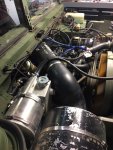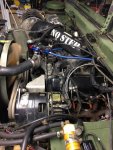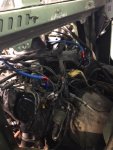Time for me to do my write-up for the kit I bought from 911joeblow!
Kit got here last Wednesday, just had a chance to get it installed today. 911joeblow shipped very quick! Bought it from him 4/15 (Saturday afternoon) and he had it shipped Monday.
First impressions of the kit... It's thorough with all of the included parts packaged neatly. The AN fittings are quality parts you'd find on a performance engine build (Fun Fact: AN fittings actually have a military heritage -
Army Navy Fitting). Buddy of mine with far more build experience than me estimated about $100 in the cost on the fittings alone. The welds on the water port covers look nice.
One thing I did wonder about when inspecting the kit was the seemingly small size of fitting openings and hose diameter as it seemed to me like larger = more flow = better so, I messaged 911joeblow about my concern and he filled me in on the logic behind it and, gave me permission to share the details of our PM conversation. So, rather than paraphrase what he sent me, I'll repost it:
There is a logic to the smaller diameter. The water pump is drawing coolant from the front of the block and we don't want to be reduced but we do want to even out the flow from the back. Coolant stagnates at the extreme rear of the block right below the block off plates. In testing we ran as large as 1/2" ID system which required a modified front crossover pipe in order to achieve the needed fitting size to accommodate the volume two 1/2 hoses produce. Once we had that system working we started to reduce the size down from 1/2" with restrictors until we started to see a balance between lost flow from the front and reduced temps in the rear cylinders. The big key here is that the main flow from the front cant be reduced significantly. We found that the AN4 size you have in your kit was ideal for both requirements. Remember that we are cooling the rearmost 1/2 of the rear cylinders with this kit. We are also eliminating air/steam pockets which form there which are very destructive. Thanks for asking about that!
Clearly T&E has been put into these kits and he's not just throwing junk together.
To compare before and after, on Monday I took a drive to establish a benchmark for comparison. Monday it was 75 degrees, according to my home weather station, and I took the truck on a roughly 11.75 mile round trip drive. Terrain is a combination of hills and flat with some back roads and state routes. I took the route I did because there is a specific spot after an uphill climb about 5.5 miles from my house that my fan will typically kick on at from a cold start, within about 1/4 mile give or take depending on outside temps (unless it is really cold then it will kick on far later). On this hill, I can get my EGTs up to 1100 no problem and have to start backing off 3/4 the way from top.
Mileage pic. Start mileage pic was about 1/4 mile from my house.
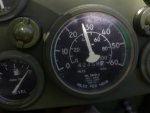
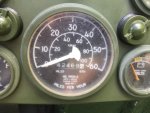
Temps at the rear of the block before setting out:
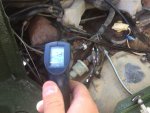
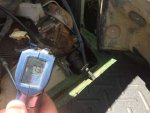
On the drive I counted 9 times my fan engaged. I don't know why it didn't dawn on my before the trip to time the fan engagements but I didn't think of it until I got home so no hard data on that unfortunately.
Post drive temp readings:
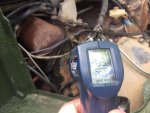
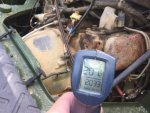
Fast forward to today when I finally had the time to install the kit... Kit installation was very straightforward and pretty easy. Took about an hour to install including gathering parts, tools, and material as well as filling the coolant up at the end. Most of the time was taken up with getting the old water outlet gasket material off. Used a razor to scrape off the bulk of it then finished with a wire wheel in a Dremel. Directions were plenty detailed and straight forward. Didn't bother with install pics since LouWon had that covered.
Today was about 10-15 degrees hotter than Monday but fortunately, as I was wrapping the install, it was getting dark and temps had dropped to 75 (again per my weather station). Took the truck out on it's test drive on the same route.
Observations from the trip... Instead of the fan kicking on at its usual spot, I managed another 3/4 mile before it finally kicked on. Total number of fan engagements went down from the 9 on the benchmark drive to just 6. As I mentioned, I neglected to time the benchmark fan engagement times but, going by ear, I'd estimate fan run time dropped perhaps 15-20%. They were noticeably shorter.
I took some temp readings after getting home and was a little surprised. Temps were actually slightly
higher by a couple degrees. I suspect this is because of the increased coolant flow resulting in more balanced temps across the engine. Temp measurements at the front probably would have helped show if this was in play and, in retrospect, something I should have done for better data.
If someone had a thermal imager and wanted to install this kit, before and after pics with one of those would certainly be best to give a more complete picture.
Post install, post test drive temp picture. Only one because the one I took of the driver's side head blurred as I was taking it. Didn't notice it until I was downloading them and had everything buttoned up. It read 207 however.
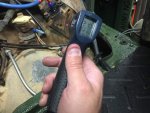
Overall impressions of the kit... Considering the cost of the materials, the time 911joeblow spent welding the water outlet covers with fittings, time assembling the hoses, and time packaging the kit (including instructions), the $250 plus shipping he asked per kit was pretty fair. And given the reductions I saw in fan run time, I'd say it does a pretty good job. Less time the fan spends running is less time it spends robbing horsepower.
We all know diesels like running hot but, it's a balancing act of keeping it to a reasonable level on these trucks which are notorious for their less than stellar cooling performance and gave rise in the '90s H1 scene to mods to improve it such as hood scoops like this (actually spotted this a couple weeks ago

):
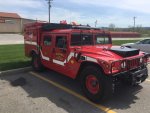
And while NA trucks aren't plagued with the #8 cylinder cracking issue that the turbo GM blocks were/are that kits like this were originally envisioned to assist in mitigating, this still seems to be a worthwhile mod to make. It is a good idea to remember that these trucks were built to government specs by the lowest bidder, by companies pinching pennies through "good enough" rather than "what works best but adds costs and cuts profit margins". Additionally, the military has a massive vehicle support infrastructure to support these trucks which your typical average owner doesn't so, even if you're adding only a small degree of reliability, it could make that difference down the road to a private owner that might be unnecessary to the big picture of the military. Improved cooling in these trucks has almost always been a good thing.
In the end it's going to be up to each owner to decide their comfort with their cost/benefit level of mods. Personally, I'm of the mindset that every bit (within reason) that I can add/change to address engineering shortcomings that have been revealed over 30+ years of production and use of these trucks, and improve the reliability/performance of my truck is good in my book, "milspec" or not. And another nice thing about this kit is, down the road when I do swap in a 6.5T drivetrain, I can move this kit over to it!




